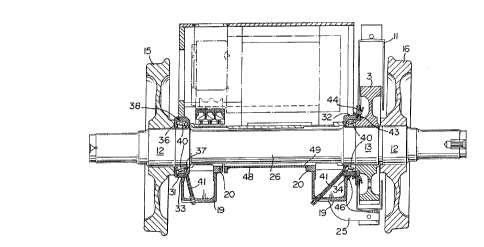Some of the information on this Web page has been provided by external sources. The Government of Canada is not responsible for the accuracy, reliability or currency of the information supplied by external sources. Users wishing to rely upon this information should consult directly with the source of the information. Content provided by external sources is not subject to official languages, privacy and accessibility requirements.
Any discrepancies in the text and image of the Claims and Abstract are due to differing posting times. Text of the Claims and Abstract are posted:
| (12) Patent: | (11) CA 2095552 |
|---|---|
| (54) English Title: | METHOD OF CONVERTING TRACTION MOTOR SUSPENSION SYSTEM |
| (54) French Title: | METHODE DE CONVERSION D'UN SYSTEME DE SUSPENSION DE MOTEUR DE TRACTION |
| Status: | Deemed expired |
| (51) International Patent Classification (IPC): |
|
|---|---|
| (72) Inventors : |
|
| (73) Owners : |
|
| (71) Applicants : | |
| (74) Agent: | FINLAYSON & SINGLEHURST |
| (74) Associate agent: | |
| (45) Issued: | 2000-12-12 |
| (22) Filed Date: | 1993-05-05 |
| (41) Open to Public Inspection: | 1994-11-06 |
| Examination requested: | 1997-08-28 |
| Availability of licence: | N/A |
| (25) Language of filing: | English |
| Patent Cooperation Treaty (PCT): | No |
|---|
| (30) Application Priority Data: | None |
|---|
Locomotive traction motors have conventionally
been used in North America with sleeve-type friction bearing
suspension systems. Roller bearing suspension systems have
been gaining acceptance in North America. There is no known
method of converting the sleeve-type systems to roller
bearing systems. This problem is overcome by a method in
which the bearing caps covering the sleeve bearings, the
sleeve bearings and the shaft are removed; recesses are
formed in the bearing caps and in the traction motor housing
proximate the ends of the traction motor for receiving
roller bearing housings at each end of the traction motor
housing; installing the roller bearing housings on an axle
and in said recesses in the bearing caps; mounting a
generally U-shaped cover between the bearing caps, the
U-shaped cover and bearing caps surrounding the central
portion of the axle; and connecting the bearing caps to the
traction housing.
Note: Claims are shown in the official language in which they were submitted.
Note: Descriptions are shown in the official language in which they were submitted.

For a clearer understanding of the status of the application/patent presented on this page, the site Disclaimer , as well as the definitions for Patent , Administrative Status , Maintenance Fee and Payment History should be consulted.
| Title | Date |
|---|---|
| Forecasted Issue Date | 2000-12-12 |
| (22) Filed | 1993-05-05 |
| (41) Open to Public Inspection | 1994-11-06 |
| Examination Requested | 1997-08-28 |
| (45) Issued | 2000-12-12 |
| Deemed Expired | 2005-05-05 |
There is no abandonment history.
| Fee Type | Anniversary Year | Due Date | Amount Paid | Paid Date |
|---|---|---|---|---|
| Application Fee | $0.00 | 1993-05-05 | ||
| Registration of a document - section 124 | $0.00 | 1993-10-22 | ||
| Maintenance Fee - Application - New Act | 2 | 1995-05-05 | $100.00 | 1995-04-10 |
| Maintenance Fee - Application - New Act | 3 | 1996-05-06 | $100.00 | 1996-05-03 |
| Maintenance Fee - Application - New Act | 4 | 1997-05-05 | $100.00 | 1997-05-05 |
| Request for Examination | $400.00 | 1997-08-28 | ||
| Maintenance Fee - Application - New Act | 5 | 1998-05-05 | $150.00 | 1998-05-04 |
| Maintenance Fee - Application - New Act | 6 | 1999-05-05 | $150.00 | 1999-05-04 |
| Registration of a document - section 124 | $100.00 | 2000-02-02 | ||
| Maintenance Fee - Application - New Act | 7 | 2000-05-05 | $150.00 | 2000-05-04 |
| Final Fee | $300.00 | 2000-09-08 | ||
| Maintenance Fee - Patent - New Act | 8 | 2001-05-07 | $150.00 | 2001-04-12 |
| Maintenance Fee - Patent - New Act | 9 | 2002-05-06 | $150.00 | 2002-04-19 |
| Maintenance Fee - Patent - New Act | 10 | 2003-05-05 | $200.00 | 2003-04-22 |
Note: Records showing the ownership history in alphabetical order.
| Current Owners on Record |
|---|
| PROGRESS RAIL CANADA CORPORATION |
| Past Owners on Record |
|---|
| CAE VANGUARD, LTD. |
| PAUCH, EDWARD |
| POPOVITS, STEPHEN |
| STASIAK, KRZYSZTOF |
| VAN DE GRAAF, ADRIAN |